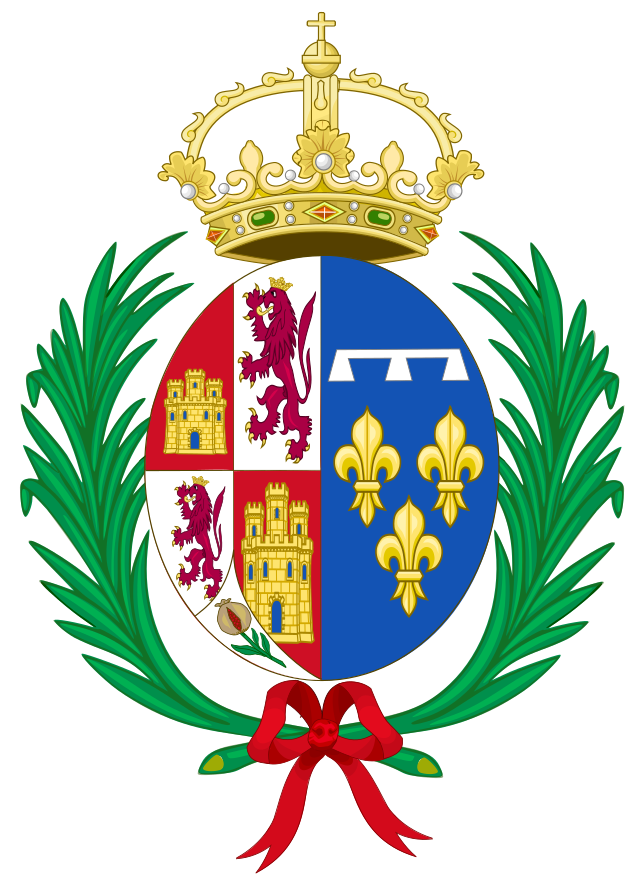Marie Louise d'Orléans
Queen of Spain from 1679 to 1689 From Wikipedia, the free encyclopedia
Marie Louise d'Orléans (Spanish: María Luisa de Orleans; 26 March 1662 – 12 February 1689) was Queen of Spain from 1679 to 1689 as the first wife of King Charles II. She was born petite-fille de France as the daughter of Philippe I, Duke of Orléans and Princess Henrietta of England. Marie became the Queen of Spain on 19 November 1679, and remained in her post until her death in 1689 from the presumed cause of appendicitis.
| Marie Louise d'Orléans | |||||
|---|---|---|---|---|---|
 Portrait in the Palace of Versailles, c. 1679 | |||||
| Queen consort of Spain | |||||
| Tenure | 19 November 1679 – 12 February 1689 | ||||
| Born | 26 March 1662 Palais Royal, Paris, France | ||||
| Died | 12 February 1689 (aged 26) Royal Alcázar, Madrid, Spain | ||||
| Burial | |||||
| Spouse | |||||
| |||||
| House | Orléans | ||||
| Father | Philippe I, Duke of Orléans | ||||
| Mother | Henrietta of England | ||||

Life
Summarize
Perspective
Childhood

Marie Louise d'Orléans was born at the Palais Royal in Paris. She was the eldest daughter of Philippe of France, Duke of Orléans and of his first wife, Princess Henrietta of England.[1] As a petite-fille de France she was entitled to the attribute of Royal Highness, although, as was customary at court at the palace of Versailles, her style, Mademoiselle d'Orléans, was more often used.
Charming, pretty and graceful, Marie Louise, who was her father's favourite child, had a happy childhood, residing most of the time in the Palais Royal, and at the château de Saint-Cloud situated a few kilometres west of Paris. Marie Louise spent a lot of time with both her paternal and maternal grandmothers—Anne of Austria, who doted on her and left the bulk of her fortune to her when she died in 1666; and Henrietta Maria, who lived in Colombes.
Marie Louise's mother died in 1670. The following year, her father married Elisabeth Charlotte of the Palatinate. All her life, Marie Louise would maintain an affectionate correspondence with her stepmother.
Queen

In July 1679,[2] Marie was informed by her father, Philippe, and uncle, King Louis XIV of her betrothal to Charles II of Spain.[3] Distressed by the arranged marriage, Marie spent most of her time weeping, since she had fallen in love with her cousin Louis.[2][4] The proxy marriage took place at the Palace of Fontainebleau on 30 August 1679; standing for the groom was Mademoiselle d'Orléans' distant cousin Louis Armand de Bourbon, Prince of Conti.[5] Until mid-September there were a series of formal events held in honour of the new Queen of Spain. Marie Louise went to the convent of Val-de-Grâce, before her departure, where the heart of her mother was kept. She would never return to France.

On 19 November 1679, Marie Louise married Charles in person in Quintanapalla, near Burgos, Spain.[6] This was the start of a lonely existence at the Spanish court. Her new husband had fallen in love with her and remained so until the end of his life.[7] However, the confining etiquette of the Spanish Court (e.g., touching the Queen was forbidden) and unsuccessful attempts to bear a child caused her distress. Her most frequent companion was the French ambassadress, Marie Gigault de Bellefonds, the Marquise de Villars.[8]
After ten years of marriage the couple had no children. Marie Louise confided to the French ambassador, that
she was really not a virgin any longer, but that as far as she could figure things, she believed she would never have children.

During the last years of her life she became overweight.[9] She was reportedly fond of sweetened lemon and cinnamon drinks, the making of which required 32 pounds of sugar.[10] After horseback riding on 11 February 1689, she experienced abdominal pain followed by convulsions and vomiting. After doctors found that her condition had become mortal, confessors were called in to administer last rites.
On her deathbed, she spoke to her husband the following words:[11]
Many women may be with His Majesty, but none will love him more than I do
She died the following night. There were rumors she was poisoned.[12][13]
Ancestry
| Ancestors of Marie Louise d'Orléans | |||||||||||||||||||||||||||||||||||||||||||||||||||||||||||||||||||||||||||||||||||||||||||||||||||||||||||||||||||||||||||||||||||||||||||||||||||||||||||||||||||||||||||||||||||||||||||||||||||||||||||||||||||||||||||||||||||||||||||||||||||||||||||||||||||||||||||||||||||||||||
|---|---|---|---|---|---|---|---|---|---|---|---|---|---|---|---|---|---|---|---|---|---|---|---|---|---|---|---|---|---|---|---|---|---|---|---|---|---|---|---|---|---|---|---|---|---|---|---|---|---|---|---|---|---|---|---|---|---|---|---|---|---|---|---|---|---|---|---|---|---|---|---|---|---|---|---|---|---|---|---|---|---|---|---|---|---|---|---|---|---|---|---|---|---|---|---|---|---|---|---|---|---|---|---|---|---|---|---|---|---|---|---|---|---|---|---|---|---|---|---|---|---|---|---|---|---|---|---|---|---|---|---|---|---|---|---|---|---|---|---|---|---|---|---|---|---|---|---|---|---|---|---|---|---|---|---|---|---|---|---|---|---|---|---|---|---|---|---|---|---|---|---|---|---|---|---|---|---|---|---|---|---|---|---|---|---|---|---|---|---|---|---|---|---|---|---|---|---|---|---|---|---|---|---|---|---|---|---|---|---|---|---|---|---|---|---|---|---|---|---|---|---|---|---|---|---|---|---|---|---|---|---|---|---|---|---|---|---|---|---|---|---|---|---|---|---|---|---|---|---|---|---|---|---|---|---|---|---|---|---|---|---|---|---|---|---|---|---|---|---|---|---|---|---|---|---|---|---|---|---|---|---|
| |||||||||||||||||||||||||||||||||||||||||||||||||||||||||||||||||||||||||||||||||||||||||||||||||||||||||||||||||||||||||||||||||||||||||||||||||||||||||||||||||||||||||||||||||||||||||||||||||||||||||||||||||||||||||||||||||||||||||||||||||||||||||||||||||||||||||||||||||||||||||
References
Sources
Wikiwand - on
Seamless Wikipedia browsing. On steroids.
